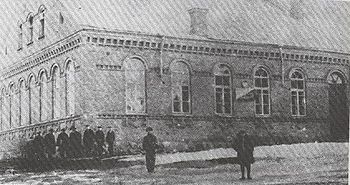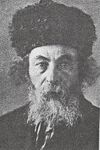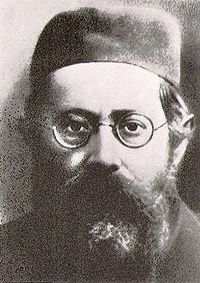
Radun Yeshiva
Encyclopedia

Poland
Poland , officially the Republic of Poland , is a country in Central Europe bordered by Germany to the west; the Czech Republic and Slovakia to the south; Ukraine, Belarus and Lithuania to the east; and the Baltic Sea and Kaliningrad Oblast, a Russian exclave, to the north...
(now Belarus
Belarus
Belarus , officially the Republic of Belarus, is a landlocked country in Eastern Europe, bordered clockwise by Russia to the northeast, Ukraine to the south, Poland to the west, and Lithuania and Latvia to the northwest. Its capital is Minsk; other major cities include Brest, Grodno , Gomel ,...
), was established by the Chofetz Chaim
Yisrael Meir Kagan
Yisrael Meir Poupko , known popularly as The Chofetz Chaim, was an influential Eastern European rabbi, Halakhist, posek, and ethicist whose works continue to be widely influential in Jewish life...
in 1869.
Origins



- “The beginning of the founding began from when I returned from the town of Vashilyshok...in the year 1869. Following my arrival in Raduń, the Almighty stirred my spirit to gather young students and scholars for the study of Torah...”
Although at the time Raduń was practically an isolated village, away from undesirable urban distractions and an ideal location for establishing a place of Torah study, living conditions were difficult. This meant that the chances of garnering enough local financial support to run a large and prosperous institution were low. This led the Chofetz Chaim to send some boys to other yeshivas, which also had better facilities, and keep the enrolment limited. The students of the yeshivas made do with sleeping on the benches in the study hall and were referred to as “perushim” because they separated themselves from worldly luxuries and immersed themselves in study of Torah. From the start meals weren’t provided at the yeshiva and students were allocated to various homes in the village where they were given meals. It was when the Chofetz Chaim felt that this set up was not befitting of yeshiva students that he abolished the so called “teg-essen” and went about arranging a house to house food collection. The collected food would then be distributed among the students. After some time a kitchen was opened by the wife of the Chofetz Chaim and she together with other women would collect provisions and cook meals which were served to the students in the yeshiva building.
The yeshiva remained small in number until 1883 when the Chofetz Chaim took on his son-in-law Rabbi Hersh Levinson as an assistant to help carry the burden running the yeshiva. After his appointment, the yeshiva expanded and the conditions improved. In 1900 Rabbi Moshe Landynski, an alumnus of the Volozhin Yeshiva
Volozhin yeshiva
The Volozhin Yeshiva, also known as Etz Chaim Yeshiva, was a prestigious Lithuanian yeshiva located in the town of Volozhin, Russia, . It was founded by Rabbi Chaim Itzkovitz, a student of the famed Vilna Gaon, and trained several generations of scholars, rabbis, and leaders...
, was appointed Rosh yeshiva
Rosh yeshiva
Rosh yeshiva, , , is the title given to the dean of a Talmudical academy . It is made up of the Hebrew words rosh — meaning head, and yeshiva — a school of religious Jewish education...
. At later stages two other deans were in turn appointed: Rabbi Yitzchak Maltzon, who eventually settled in Jerusalem, and Rabbi Baruch Ish Alaksot, who later became a Rosh yeshiva in Slabodka Yeshiva
Slabodka yeshiva
Hebron Yeshiva, also known as Yeshivas Hevron, or Knesses Yisroel, and originally as Slabodka Yeshiva, is known colloquially as the "mother of yeshivas" and was devoted to high=level study of the Talmud. The yeshiva was located in the Lithuanian town of Slabodka, adjacent to Kovno , now...
. Rabbi Eliezer Lufet also served as Mashgiach ruchani
Mashgiach ruchani
Mashgiach ruchani or mashgiach for short, means a spiritual supervisor or guide. It is a title which usually refers to a rabbi who has an official position within a yeshiva and is responsible for the non-academic areas of yeshiva students' lives.The position of mashgiach ruchani arose with the...
for a short period.
New yeshiva building
In 1904, after the influx of students, the local Beth midrashBeth midrash
Beth Midrash refers to a study hall, whether in a synagogue, yeshiva, kollel, or other building. It is distinct from a synagogue, although many synagogues are also used as batei midrash and vice versa....
became too small to accommodate the yeshiva and a new building was constructed to house the college. However, as the years progressed, so did the student intake and with pupils now numbering in the hundreds, some were forced to study in the local synagogue. This set up was not favoured by the faculty who decided that a new, larger building, able to hold the entire student roll, was needed. And so it was, in 1912 that the original building was demolished to make way for a new edifice which would be big enough to contain all the students, which at the time exceeded 300. The Chofetz Chaim raised the 15,000 ruble
Ruble
The ruble or rouble is a unit of currency. Currently, the currency units of Belarus, Russia, Abkhazia, South Ossetia and Transnistria, and, in the past, the currency units of several other countries, notably countries influenced by Russia and the Soviet Union, are named rubles, though they all are...
s necessary for the task and construction was finished in 1913. The finished building not only included a spacious study hall, but also dormitories, side rooms uses for various functions, a medical room and a library where thousands of volumes were kept.
World War I

Naftoli Trop
Rabbi Naftoli Trop was the Rosh yeshiva of Yeshiva Chofetz Chaim in Raduń, Poland. He was a renowned Talmudist and Talmid Chacham.-Early years:...
was invited to take up the position as Rosh yeshiva. His appointment ushered in the yeshiva’s “golden era”. Under his guidance the yeshiva grew and during the 1920’s became one of the largest in Europe. From 1907 until 1910 the Mashgiach ruchani was Rabbi Yeruchom Levovitz who later joined the Mir Yeshiva
Mir yeshiva (Poland)
The Mir yeshiva , commonly known as the Mirrer Yeshiva or The Mir, was a Haredi yeshiva located in the town of Mir, Russian Empire...
.
After the outbreak of war between Germany
Germany
Germany , officially the Federal Republic of Germany , is a federal parliamentary republic in Europe. The country consists of 16 states while the capital and largest city is Berlin. Germany covers an area of 357,021 km2 and has a largely temperate seasonal climate...
and Russia
Russia
Russia or , officially known as both Russia and the Russian Federation , is a country in northern Eurasia. It is a federal semi-presidential republic, comprising 83 federal subjects...
in 1914, the Chofetz Chaim worried about the potential German occupation and the effect it would have on the yeshiva. There was also the threat of the town becoming severed from Russia and thus stemming its source of funding. In 1915 as the Russians retreated and the German army neared Raduń, the decision was taken that the yeshiva would be split into two parts. One would stay in Raduń and the second would move further inside Russia. Most of the students including the Chofetz Chaim, his son-in-law and Rabbi Trop left Raduń, while the minority remained with Rabbi Moshe Landynski and the Mashgiach ruchani Rabbi Yosef Leib Nendik. The second part of the yeshiva settled in Smilovitz in the Province of Minsk. In 1916 a new refuge was sought as the battle-line drew closer and the yeshiva moved further into Russia, to Shumyatz in the Province of Mohilov
Mahilyow Voblast
Mahilyow Voblasts or Mogilyov Oblast is a province of Belarus with its administrative center being Mogilyov ....
and latter to Snovsk in the Province of Chernigov, (currently Shchors City, Ukraine
Ukraine
Ukraine is a country in Eastern Europe. It has an area of 603,628 km², making it the second largest contiguous country on the European continent, after Russia...
). German forces occupied Minsk
Minsk
- Ecological situation :The ecological situation is monitored by Republican Center of Radioactive and Environmental Control .During 2003–2008 the overall weight of contaminants increased from 186,000 to 247,400 tons. The change of gas as industrial fuel to mazut for financial reasons has worsened...
in February 1918. It was a turbulent period with the authorities arresting students who were freed only after much effort and expanse. With the rise of communism the situation was not set to improve. After the authorities made it impossible for the yeshiva to survive in Russia the yeshiva looked to Poland and towards Raduń. The move back to Raduń was hastened with the death of Rabbi Hersh Leib Levinson in 1921 after a short illness.
Return to Raduń
After encountering difficulties in obtaining permission to travel and cross the border into newly independent Poland, the yeshiva was delayed in Minsk for around two months. When permission was finally granted the yeshiva arrived in Baranowitz and where they stayed for a few days. In the spring of 1921 the yeshiva arrived back to Raduń. Rabbi Moshe Landynski was at the train station to greet the returnees. It was a joyous occasion, however their joy was short lived. When they arrived back at the yeshiva they found the inside of the building destroyed and abandoned. The Germans had confiscated the building for use as a horse stable and ammunition store, forcing the students to occupy the local Beth midrash. The windows were smashed and the furniture gone. The only option was to utilise the building as it stood and begin efforts to refurbish it. With time, the return of the yeshiva to it home endowed it with a new lease of life under the leadership of both Rabbi Naftoli Trop and Rabbi Moshe Landynski. Rabbi Levinson’s son Yehoshua became supervisor and his son-in-law Eliezer Kaplan the Mashgiach ruchani.With the passing of Rabbi Trop in 1928, the prominence of the yeshiva slowly diminished. Even with the appointment of two young Rosh yeshivas, Rabbi Baruch Feivelson (Trop’s son-in-law) and Rabbi Mendel Zaks
Mendel Zaks
Rabbi Menachem Mendel Yosef Zaks is best known for being the Rosh Yeshiva in Raduń Yeshiva and being the son-in-law to Rabbi Yisrael Meir Kagan, the Chofetz Chaim.Rabbi Zaks was born in Siluva...
(son-in-law of the Chofetz Chaim), the yeshiva would never fully regain its famed status.
Upon the death of Rabbi Baruch Feivelson in 1933, Rabbi Mendel Zaks became the sole Rosh yeshiva. Rabbi Avraham Trop also gave lectures in his fathers style which proved popular with the older students. The institution also included a kollel
Kollel
A kollel is an institute for full-time, advanced study of the Talmud and rabbinic literature. Like a yeshiva, a kollel features shiurim and learning sedarim ; unlike a yeshiva, the student body of a kollel are all married men...
, which focused on the study of Kodashim
Kodashim
Kodashim or Qodhashim is the fifth Order in the Mishna . Of the six Orders of the Mishna, it is the third longest...
. Rabbi Elchonon Wasserman
Elchonon Wasserman
Elchonon Wasserman was a prominent rabbi and rosh yeshiva in pre-World War II Europe. He was one of the Chofetz Chaim's closest disciples and a noted Torah scholar.-Biography:...
and Rabbi Yosef Shlomo Kahaneman
Yosef Shlomo Kahaneman
Yosef Shlomo Kahaneman , יוסף שלמה כהנמן, was an Orthodox rabbi and rosh yeshiva of the Ponevezh yeshiva. He was a renowned Torah and Talmudic scholar.- Biography :...
were among those who studied there.
Although the Chofetz Chaim rarely gave lectures in the yeshiva and never held the position of Rosh yeshiva, he was it’s driving force. When he died in 1933, the continued funding of the academy became an issue. Rabbi Moshe Landynski was forced to travel as far away as London
London
London is the capital city of :England and the :United Kingdom, the largest metropolitan area in the United Kingdom, and the largest urban zone in the European Union by most measures. Located on the River Thames, London has been a major settlement for two millennia, its history going back to its...
to solicit funds. Rabbi Landynski himself died a few years later in 1938 aged 77.
World War II
With the outbreak of World War IIWorld War II
World War II, or the Second World War , was a global conflict lasting from 1939 to 1945, involving most of the world's nations—including all of the great powers—eventually forming two opposing military alliances: the Allies and the Axis...
the Soviet Union
Soviet Union
The Soviet Union , officially the Union of Soviet Socialist Republics , was a constitutionally socialist state that existed in Eurasia between 1922 and 1991....
took Raduń. The majority of the yeshiva transferred to Vilna, Lithuania
Lithuania
Lithuania , officially the Republic of Lithuania is a country in Northern Europe, the biggest of the three Baltic states. It is situated along the southeastern shore of the Baltic Sea, whereby to the west lie Sweden and Denmark...
, while a few remained behind in Raduń, including the Chofetz Chaim’s stepson-in-law Rabbi Mordechai Dov Roitblatt, Rabbi Hillel Ginsburg, brother-in-law of Eliezer Zev Kaplan, and Rabbi Avraham Trop. When conditions in the Vilna became too crowded the yeshiva decided to split in two again with one half locating to Isheshuk under Yehoshua Levinson and the other to Otian. When the Soviets took Lithuania the yeshiva ceased functioning. Although much effort was made in trying to enable the yeshiva to escape, only a few individuals were able to obtain visas and emigrate.
Re-establishment in the USA
After World War II, Rabbi Mendel Zaks re-established the yeshiva in the United StatesUnited States
The United States of America is a federal constitutional republic comprising fifty states and a federal district...
. He was later joined by his son Rabbi Gershon Zaks. Reb Gershon was a student of Rabbi Yitzchak Zev Soloveitchik
Yitzchak Zev Soloveitchik
Yitzchok Zev Halevi Soloveitchik , also known as Velvel Soloveitchik or as the Brisker Rov Yitzchok Zev Halevi Soloveitchik (Hebrew: יצחק זאב הלוי סולובייצ'יק), also known as Velvel Soloveitchik ("Zev" means "wolf" in Hebrew, and "Velvel" is the diminutive of "wolf" in Yiddish) or as the Brisker...
, the "Brisker Rov". In the early 1960s the yeshiva moved to Tallman, New York
Tallman, New York
Tallman is a hamlet in the Town of Ramapo in Rockland County, New York, United States, located north of the state of New Jersey; east of Suffern; south of Montebello and west of Airmont. It is located north-northwest of New York City.-History:...
, (now part of Suffern, New York
Suffern, New York
Suffern is a village in the Town of Ramapo, Rockland County, New York, United States located north of the State of New Jersey; east of Hillburn; south of Montebello and west of Airmont...
). After the death of Rabbi Mendel Zaks in 1974, his son Gershon Zaks inherited his position until his death in 1990. Today Rabbi Yisroel Mayer Zaks and Rabbi Aryeh Zev Zaks head the The Yeshiva.
Re-establishment in Israel
The son of Rabbi Moshe Landynski settled in NetanyaNetanya
Netanya is a city in the Northern Centre District of Israel, and is the capital of the surrounding Sharon plain. It is located north of Tel Aviv, and south of Haifa between the 'Poleg' stream and Wingate Institute in the south and the 'Avichail' stream in the north.Its of beaches have made the...
, Israel
Israel
The State of Israel is a parliamentary republic located in the Middle East, along the eastern shore of the Mediterranean Sea...
where he also established a yeshiva in memory of Radin. In 2005 it had a student roll of 100 boys aged 17-22. The current Rosh yeshiva is Rabbi Menachem Dan Meisels, a student of Rabbi Baruch Mordechai Ezrachi. The yeshivas ethos reflects the Slabodka
Slabodka yeshiva
Hebron Yeshiva, also known as Yeshivas Hevron, or Knesses Yisroel, and originally as Slabodka Yeshiva, is known colloquially as the "mother of yeshivas" and was devoted to high=level study of the Talmud. The yeshiva was located in the Lithuanian town of Slabodka, adjacent to Kovno , now...
approach.
Notable alumni
- Rabbi Meyer AbovitzMeyer AbovitzMeyer Abovitz was a Rabbi and Rosh Yeshiva active in Mizrachi in Eastern Europe between the Two World Wars....
- Rabbi Samuel BelkinSamuel BelkinRabbi Samuel Belkin is best known as the second University President of Yeshiva University. A distinguished Torah scholar, he is credited with leading Yeshiva University through a period of substantial expansion .-Biography:...
- Rabbi Yosef Shlomo KahanemanYosef Shlomo KahanemanYosef Shlomo Kahaneman , יוסף שלמה כהנמן, was an Orthodox rabbi and rosh yeshiva of the Ponevezh yeshiva. He was a renowned Torah and Talmudic scholar.- Biography :...
- Rabbi Yechezkel LevensteinYechezkel LevensteinYechezkel Levenstein, known as Reb Chatzkel, , was the mashgiach ruchani of the Mir yeshiva, in Mir, Belarus and during the yeshiva's flight to Lithuania and on to Shanghai due to the invasion of Poland by Nazi Germany in World War II...
- Rabbi Naftoli ShapiroNaftoli ShapiroRabbi Naftoli Shapiro was an Orthodox Talmudic scholar and rosh yeshiva in Glasgow for 40 years.Born in 1906 in the town of Mir, Poland, Rabbi Shapiro studied at the prestigious Mir yeshiva from the age of twelve. He also learned at the Raduń Yeshiva, and was a pupil of the Chofetz Chaim...
- Rabbi Elchonon WassermanElchonon WassermanElchonon Wasserman was a prominent rabbi and rosh yeshiva in pre-World War II Europe. He was one of the Chofetz Chaim's closest disciples and a noted Torah scholar.-Biography:...

